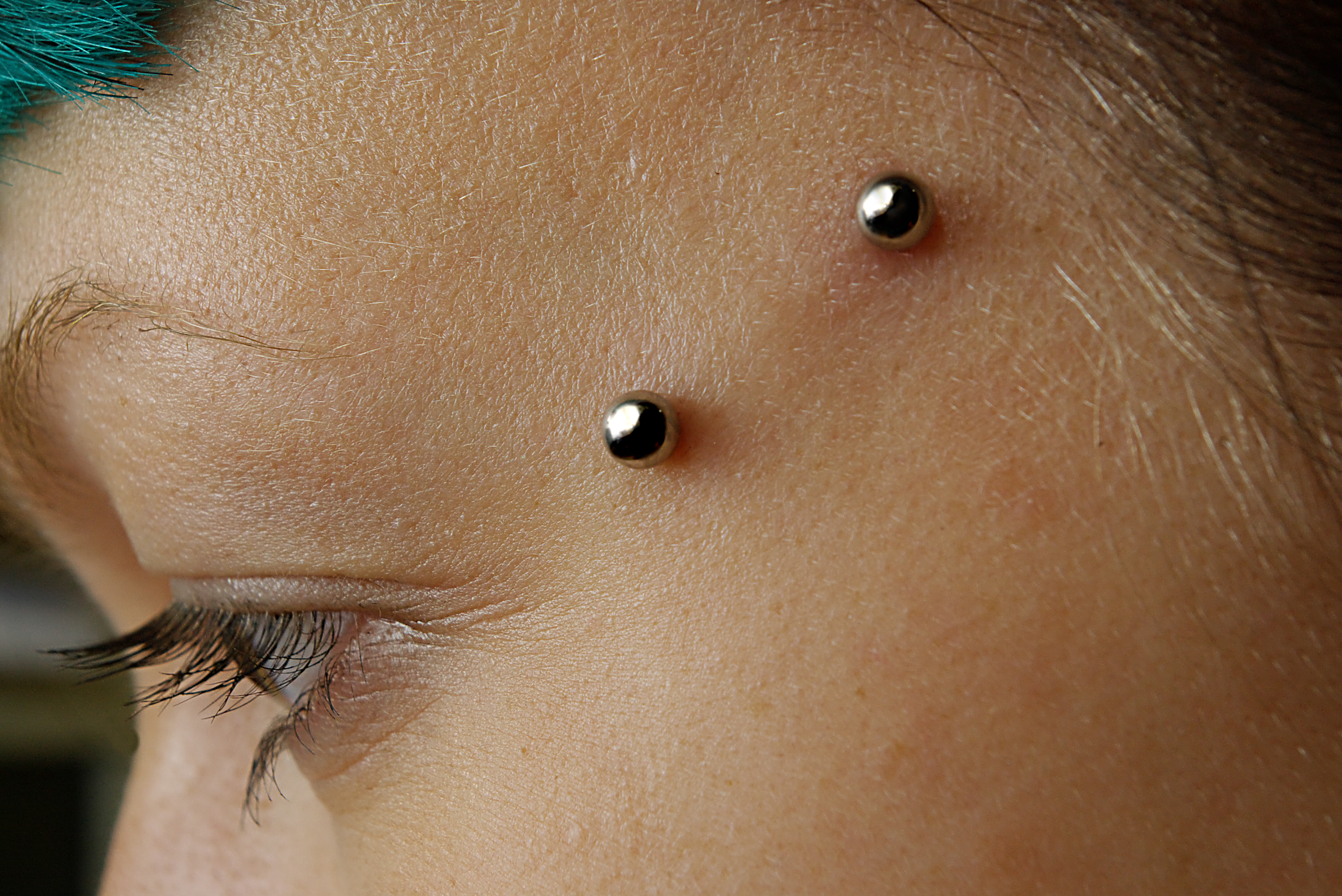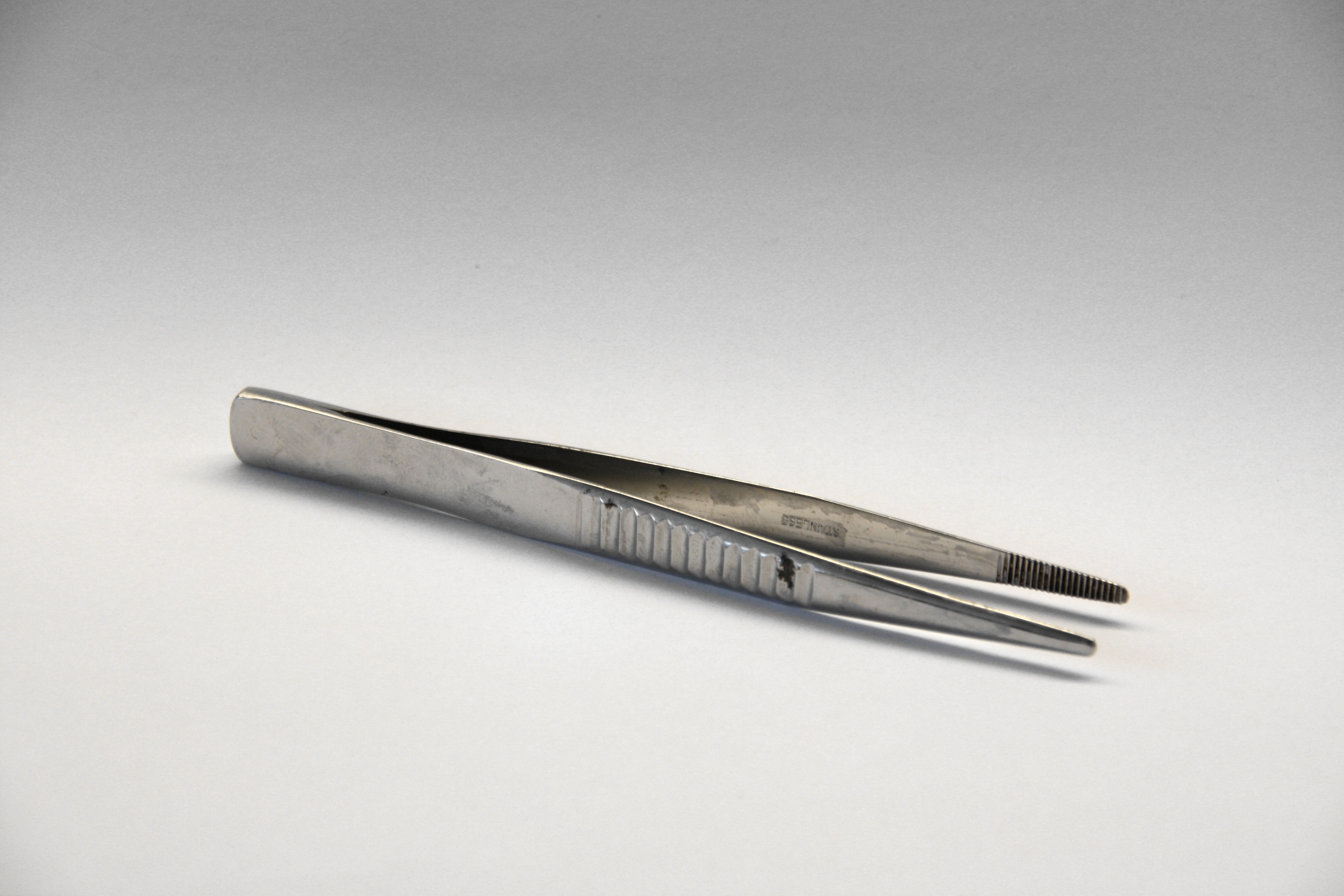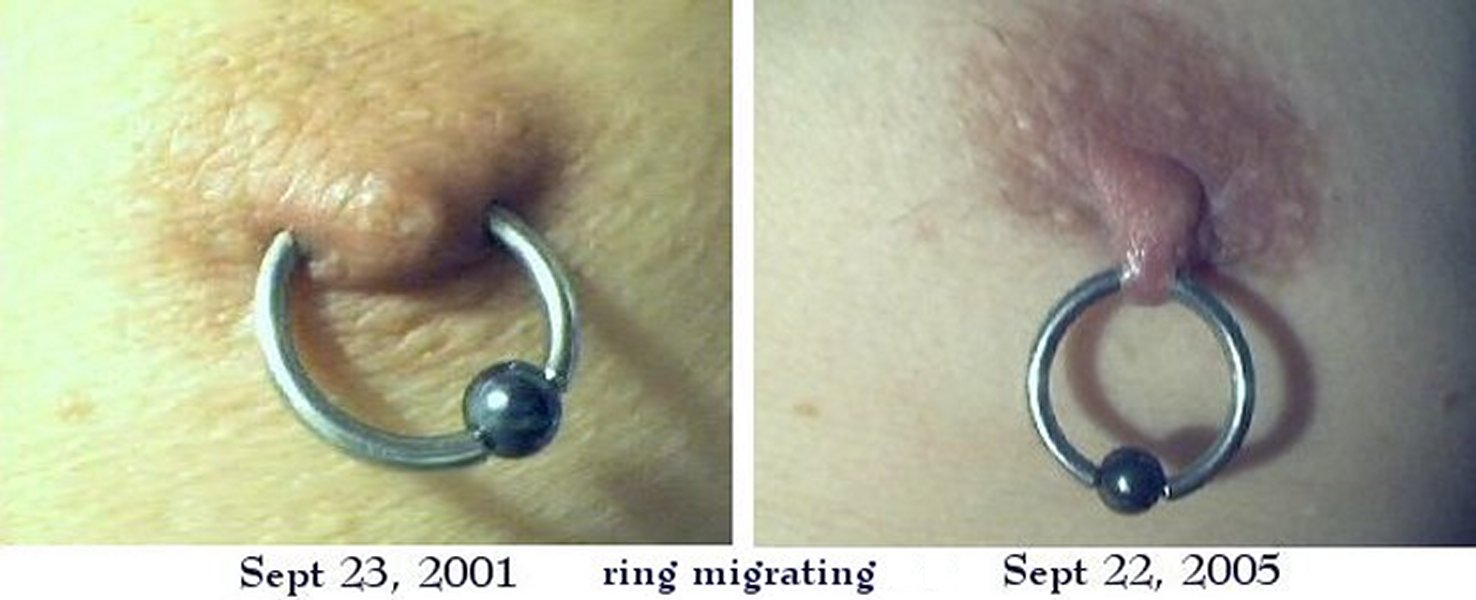|
Hip Piercing
A hip piercing is a piercing in the pelvic area through the skin near the hip bone. Hip piercings are often done in couplets with one on each hip, but it is not unusual to see only one. Hips piercing are a type of surface piercing. Microdermals or skin divers can be implanted in the hip area to give a similar appearance. Jewelry This piercing is generally fitted with a surface barbell. This type of jewelry is usually surgical steel or titanium, with two 90 degree angles that can be shaped in various ways to better fit the anatomy of the piercing. Some artists also use Tygon jewelry. This is a type of plastic that is said to reduce stress on the piercing because the long surface bars are better. This is because more skin is pierced and the piercing is less superficial which reduces the risk of rejection. Skin divers and dermal anchors are becoming more common in hip piercings due to their slightly lower rejection rate and higher longevity than surface bars. Hip piercings heal wi ... [...More Info...] [...Related Items...] OR: [Wikipedia] [Google] [Baidu] |
Surface Piercing
Surface piercings are piercings that are found on flat parts of the body, giving a double-pierced look that sits flat against the skin. A surface bar follows the plane of skin, while a standard piercing is pierced through the plane. Standard piercings have an entrance hole with an exit hole that is usually directly behind the entrance hole, whereas with a surface piercing the entrance and exit holes are next to each other on the skin surface. Types Some examples of surface piercings: *Corset piercing: a series of bilaterally symmetrical piercings, normally done on the back, intended to be laced like a corset. *Christina piercing: located at the mons pubis. *Madison piercing: a horizontal piercing located just above the collarbone, at the base of the neck. *Nape piercing: located on the back of the neck. *Neck piercing: located on the side of the neck. It is also called "Vampire Bites". *Hip piercing: located on or beside the hips (on the pelvis near the hips bones). *Wrist piercin ... [...More Info...] [...Related Items...] OR: [Wikipedia] [Google] [Baidu] |
Microdermal
Transdermal implants, or dermal piercings, are a form of body modification used both in a medical and aesthetic context. In either case, they consist of an object placed partially below and partially above the skin, thus ''trans''dermal. The skin around it generally heals as if it were a piercing. In the body piercing community, these types of modification are generally called fairly "heavy" due to the complexity of the procedure and the social implications. Two types of implants can be used. Procedure When the procedure is done using a post-like implant, an incision is made a small distance from the site. The skin is then lifted and the implant is passed through. Then, a hole is opened at the site for it to pass through, and it is moved so that the top part fills the hole. The implants used for this are generally small and not textured in any way except rounding. If a more graphic implant is desired, it is generally done in two parts. First, the base is inserted the same way ... [...More Info...] [...Related Items...] OR: [Wikipedia] [Google] [Baidu] |
Microdermal Implants
Transdermal implants, or dermal piercings, are a form of body modification used both in a medical and aesthetic context. In either case, they consist of an object placed partially below and partially above the skin, thus ''trans''dermal. The skin around it generally heals as if it were a piercing. In the body piercing community, these types of modification are generally called fairly "heavy" due to the complexity of the procedure and the social implications. Two types of implants can be used. Procedure When the procedure is done using a post-like implant, an incision is made a small distance from the site. The skin is then lifted and the implant is passed through. Then, a hole is opened at the site for it to pass through, and it is moved so that the top part fills the hole. The implants used for this are generally small and not textured in any way except rounding. If a more graphic implant is desired, it is generally done in two parts. First, the base is inserted the same way a s ... [...More Info...] [...Related Items...] OR: [Wikipedia] [Google] [Baidu] |
Forceps
Forceps (plural forceps or considered a plural noun without a singular, often a pair of forceps; the Latin plural ''forcipes'' is no longer recorded in most dictionaries) are a handheld, hinged instrument used for grasping and holding objects. Forceps are used when fingers are too large to grasp small objects or when many objects needed to be held at one time while the hands are used to perform a task. The term "forceps" is used almost exclusively in the fields of biology and medicine. Outside biology and medicine, people usually refer to forceps as tweezers, tongs, pliers, clips or clamps. Mechanically, forceps employ the principle of the lever to grasp and apply pressure. Depending on their function, basic surgical forceps can be categorized into the following groups: # Non-disposable forceps. They should withstand various kinds of physical and chemical effects of body fluids, secretions, cleaning agents, and sterilization methods. # Disposable forceps. They are usually made o ... [...More Info...] [...Related Items...] OR: [Wikipedia] [Google] [Baidu] |
Surface Piercings
Surface piercings are piercings that are found on flat parts of the body, giving a double-pierced look that sits flat against the skin. A surface bar follows the plane of skin, while a standard piercing is pierced through the plane. Standard piercings have an entrance hole with an exit hole that is usually directly behind the entrance hole, whereas with a surface piercing the entrance and exit holes are next to each other on the skin surface. Types Some examples of surface piercings: *Corset piercing: a series of bilaterally symmetrical piercings, normally done on the back, intended to be laced like a corset. *Christina piercing: located at the mons pubis. *Madison piercing: a horizontal piercing located just above the collarbone, at the base of the neck. *Nape piercing: located on the back of the neck. *Neck piercing: located on the side of the neck. It is also called "Vampire Bites". *Hip piercing: located on or beside the hips (on the pelvis near the hips bones). *Wrist piercin ... [...More Info...] [...Related Items...] OR: [Wikipedia] [Google] [Baidu] |
Barbell (piercing)
Barbell style piercing jewelry is composed of a straight bar with a bead on each end, one or both beads unscrewable for removal and/or changing of the beads. Often one of the beads is fixed, either via epoxy or welding, so that only one bead is used to install or remove the jewelry. Barbell threads are usually right-handed. They are named because they resemble the barbells that are used in weightlifting. Types of barbells Internally threaded barbells Named because the bar has smooth ends with receiving threads tapped into the end of the bar. In internally threaded jewelry, the bead has a receiving tube machined into it (this is referred to as "countersunk"), with a threaded post extending from the center, which mates with the threaded receiving tube on the bar. Being much less likely to cause damage and irritation, especially at the time of piercing, internally threaded jewelry is considered superior to externally threaded jewelry. It is usually slightly more expe ... [...More Info...] [...Related Items...] OR: [Wikipedia] [Google] [Baidu] |
Piercing Migration
Piercing migration is the process that occurs when a body piercing moves from its initial location. This process can be painful or go unnoticed, until it has progressed. Given enough time, a ring may migrate entirely outside of the skin, although it may only migrate a small amount and come to rest. Potential causes and effects of migration The effects of migration can vary widely. The most common form of migration is the way that heavy small gauge earrings will migrate downwards out of the earlobe, as is common in older women who have worn earrings most of their lives. This is known as the "cheesecutter effect", as its action is easily compared to the method of cutting cheese with a fine wire. Contemporary body and ear piercing jewelry is much more balanced in its weight to gauge ratio, although migration is still possible with heavy jewelry, even if it is of large gauge. Play or movement of the area pierced or implanted can also lead to migration, but it's not likely. Sometimes ... [...More Info...] [...Related Items...] OR: [Wikipedia] [Google] [Baidu] |
Dermis
The dermis or corium is a layer of skin between the epidermis (with which it makes up the cutis) and subcutaneous tissues, that primarily consists of dense irregular connective tissue and cushions the body from stress and strain. It is divided into two layers, the superficial area adjacent to the epidermis called the papillary region and a deep thicker area known as the reticular dermis.James, William; Berger, Timothy; Elston, Dirk (2005). ''Andrews' Diseases of the Skin: Clinical Dermatology'' (10th ed.). Saunders. Pages 1, 11–12. . The dermis is tightly connected to the epidermis through a basement membrane. Structural components of the dermis are collagen, elastic fibers, and extrafibrillar matrix.Marks, James G; Miller, Jeffery (2006). ''Lookingbill and Marks' Principles of Dermatology'' (4th ed.). Elsevier Inc. Page 8–9. . It also contains mechanoreceptors that provide the sense of touch and thermoreceptors that provide the sense of heat. In addition, hair follicles, ... [...More Info...] [...Related Items...] OR: [Wikipedia] [Google] [Baidu] |
Infection
An infection is the invasion of tissues by pathogens, their multiplication, and the reaction of host tissues to the infectious agent and the toxins they produce. An infectious disease, also known as a transmissible disease or communicable disease, is an illness resulting from an infection. Infections can be caused by a wide range of pathogens, most prominently bacteria and viruses. Hosts can fight infections using their immune system. Mammalian hosts react to infections with an innate response, often involving inflammation, followed by an adaptive response. Specific medications used to treat infections include antibiotics, antivirals, antifungals, antiprotozoals, and antihelminthics. Infectious diseases resulted in 9.2 million deaths in 2013 (about 17% of all deaths). The branch of medicine that focuses on infections is referred to as infectious disease. Types Infections are caused by infectious agents (pathogens) including: * Bacteria (e.g. ''Mycobacterium tuberculosis'', ... [...More Info...] [...Related Items...] OR: [Wikipedia] [Google] [Baidu] |
Inflammation
Inflammation (from la, wikt:en:inflammatio#Latin, inflammatio) is part of the complex biological response of body tissues to harmful stimuli, such as pathogens, damaged cells, or Irritation, irritants, and is a protective response involving immune cells, blood vessels, and molecular mediators. The function of inflammation is to eliminate the initial cause of cell injury, clear out necrotic cells and tissues damaged from the original insult and the inflammatory process, and initiate tissue repair. The five cardinal signs are heat, pain, redness, swelling, and Functio laesa, loss of function (Latin ''calor'', ''dolor'', ''rubor'', ''tumor'', and ''functio laesa''). Inflammation is a generic response, and therefore it is considered as a mechanism of innate immune system, innate immunity, as compared to adaptive immune system, adaptive immunity, which is specific for each pathogen. Too little inflammation could lead to progressive tissue destruction by the harmful stimulus (e.g. b ... [...More Info...] [...Related Items...] OR: [Wikipedia] [Google] [Baidu] |







